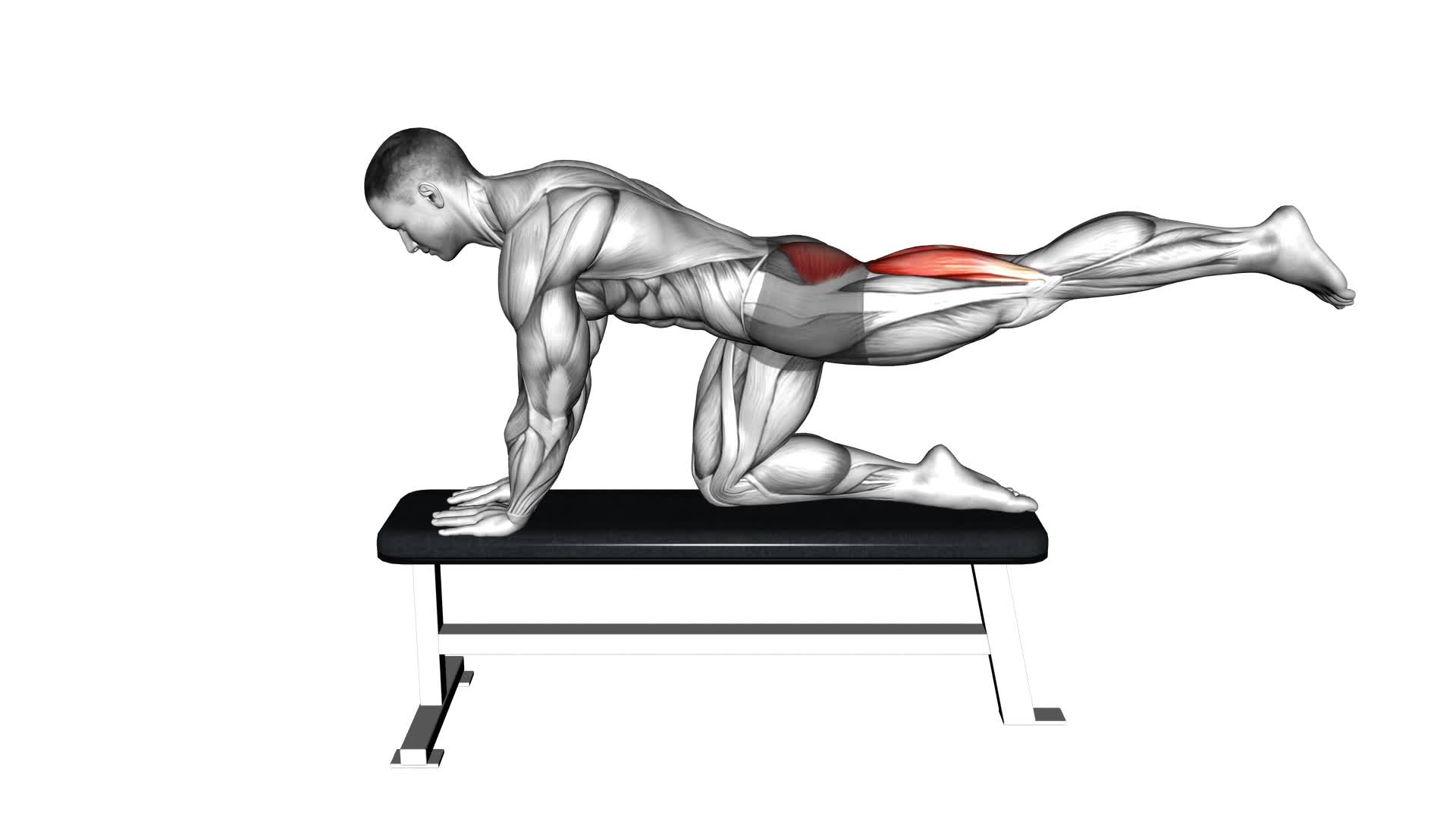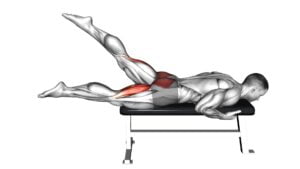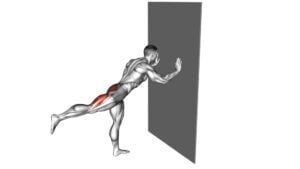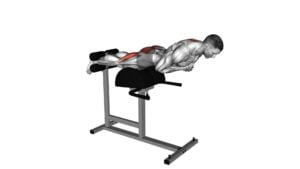Bench Hip Extension – Video Exercise Guide & Tips

Are you looking to strengthen your glutes and improve your lower body strength? Look no further than the bench hip extension.
Watch This Exercise Video
This exercise targets your glute muscles and can be done with minimal equipment. In this video exercise guide, we'll show you the proper form and technique for bench hip extension, along with common mistakes to avoid.
Get ready to maximize your results and take your lower body workouts to the next level.
Key Takeaways
- Bench hip extension targets glute muscles and strengthens the posterior chain.
- It improves overall lower-body strength, power, and hip mobility.
- It reduces the risk of injuries by improving muscle activation and stability.
- Variations and progressions of bench hip extension challenge different muscle groups and prevent plateaus.
Benefits of Bench Hip Extension
To understand the benefits of bench hip extension, you need to know that it's an effective exercise that targets your glutes and strengthens your posterior chain. Improved glute strength is one of the key benefits of this exercise. The glutes are the largest muscles in your body and play a crucial role in many lower-body movements. By specifically targeting and strengthening the glutes through bench hip extension, you can enhance your overall lower-body strength and power.
Additionally, bench hip extension can help increase hip mobility. The hip joint is a ball-and-socket joint that allows for a wide range of movements, including flexion, extension, abduction, and adduction. However, many people have limited hip mobility due to sedentary lifestyles and prolonged sitting. By performing bench hip extensions, you can actively work on increasing the range of motion in your hips, which can improve your overall movement quality and reduce the risk of injuries.
Equipment Needed for Bench Hip Extension
You will need a bench for performing the hip extension exercise. When choosing a bench, consider its stability and durability. Look for a bench that can support your body weight and provide a stable surface for the exercise.
There are different equipment options available for performing the bench hip extension exercise. One option is a standard weight bench, which is commonly found in gyms. This type of bench usually has a flat or slightly inclined surface and can be adjusted to different heights.
Another option is a step platform, which can be used as a bench substitute. Step platforms are versatile and can be adjusted to different heights, allowing for modifications and regressions as needed. Modifications and regressions can be made by adjusting the height of the bench or step platform.
Lowering the height of the bench or step platform can make the exercise easier, while raising the height can increase the difficulty. Additionally, you can use resistance bands or weights to add intensity to the exercise.
Remember to choose a bench or step platform that suits your needs and provides a stable surface for performing the hip extension exercise. By making modifications and regressions, you can tailor the exercise to your fitness level and gradually progress over time.
Proper Form and Technique for Bench Hip Extension
To perform the bench hip extension exercise with proper form and technique, it's important to focus on engaging your glutes and maintaining a stable core. Here are some key points to keep in mind:
- Start by lying face down on the bench with your hips at the edge and your legs extended straight behind you.
- Place your hands on the bench for support and keep your neck in a neutral position.
- Squeeze your glutes and lift your legs off the ground, making sure to keep them straight and in line with your body.
- Lower your legs back down in a controlled manner, without letting them touch the ground.
By following these steps, you'll be able to maximize glute activation during the bench hip extension exercise. Engaging your glutes is crucial for targeting and strengthening these muscles effectively.
Transition: Now that you understand the proper form and technique for bench hip extension, it's important to also be aware of common mistakes that can hinder your progress.
Common Mistakes to Avoid During Bench Hip Extension
When performing the bench hip extension exercise, it's important to be mindful of common mistakes that can hinder your progress. By avoiding these mistakes, you can ensure that you're maximizing the benefits of this exercise while minimizing the risk of injuries.
One common misconception is using momentum instead of muscle power. It's crucial to engage your glutes and hamstrings to lift your legs, rather than relying on the momentum of swinging your legs up.
Another mistake to avoid is arching your lower back excessively. This can put unnecessary strain on your spine and increase the risk of injury. Instead, focus on maintaining a neutral spine throughout the movement.
Additionally, it's important to avoid lifting your legs too high. Lifting your legs beyond your hip level can cause your lower back to hyperextend, which can lead to discomfort and potential injuries.
Lastly, make sure to keep your core engaged throughout the exercise. This will help stabilize your body and prevent any unnecessary movements or compensations.
Variations and Progressions of Bench Hip Extension
To further challenge yourself and continue progressing in the bench hip extension exercise, there are several variations and progressions that you can incorporate into your routine. These modifications won't only target different muscle groups but also prevent boredom and plateaus in your training.
Here are four variations and progressions to consider:
- Single-leg bench hip extension: By performing the exercise with one leg at a time, you increase the demand on the glutes and hamstrings of the working leg, leading to greater strength gains and improved balance.
- Weighted bench hip extension: Adding extra resistance, such as holding a dumbbell, kettlebell, or a weight plate on your hips, increases the difficulty of the exercise and further activates the targeted muscles.
- Banded bench hip extension: By placing a resistance band around your thighs, you introduce a lateral resistance that challenges your hip abductors and gluteus medius, helping to improve hip stability and prevent knee injuries.
- Swiss ball bench hip extension: Performing the exercise on a Swiss ball instead of a bench engages your core muscles to a greater extent, as you have to stabilize your body on an unstable surface.
Tips for Maximizing Results With Bench Hip Extension
To maximize your results with bench hip extension, it's crucial to focus on proper form techniques and effective muscle activation.
Ensure that your back remains flat against the bench throughout the exercise, and engage your glutes and hamstrings to drive the movement.
Proper Form Techniques
For maximum results with bench hip extension, focus on maintaining proper form throughout the exercise. Here are some tips to help you maximize your results:
- Start by positioning yourself on the bench with your hips at the edge and your feet firmly on the ground.
- Keep your core engaged and your back straight throughout the movement.
- As you lift your hips, squeeze your glutes and engage your hamstrings.
- Avoid using momentum or swinging your legs to perform the exercise. Instead, focus on controlled movements and a full range of motion.
By following these proper form techniques, you can ensure that you're targeting the right muscles and getting the most out of your bench hip extension exercise.
Effective Muscle Activation
To maximize your results with bench hip extension, consistently engage your glutes and hamstrings throughout the exercise. Muscle activation techniques are crucial for targeting and activating the right muscles during hip extension exercises.
First, focus on initiating the movement from your glutes. Squeeze your glute muscles as you lift your hips off the bench, ensuring a strong contraction. This will help to activate and strengthen your glutes effectively.
Additionally, engage your hamstrings by keeping them tense throughout the exercise. Imagine pulling your heels towards your glutes, emphasizing the contraction in the back of your legs.
Frequently Asked Questions
How Many Sets and Reps Should I Do for Bench Hip Extension?
To maximize the effectiveness of bench hip extension, it's important to determine the appropriate number of sets and reps for your fitness goals. Without considering the specific exercise, it's generally recommended to perform 3-4 sets of 8-12 reps for muscle growth and strength.
This technique targets the glutes and hamstrings, providing benefits such as improved lower body strength and stability. Variations, such as adding resistance or performing single-leg extensions, can further challenge your muscles and enhance your workout.
Can Bench Hip Extension Help to Improve My Posture?
Improving your posture is vital for overall health. Good posture helps alleviate back pain, improves breathing, and enhances confidence.
Incorporating hip extension exercises into your workout routine can contribute to better posture. By strengthening your glutes and lower back muscles, bench hip extensions engage the muscles needed for maintaining proper alignment.
This exercise can help counteract the negative effects of prolonged sitting and improve your overall posture.
Is Bench Hip Extension a Suitable Exercise for Beginners?
Yes, bench hip extension is a suitable exercise for beginners.
If you're just starting out, there are modification options available to make it easier for you. You can start with a lower bench height or use a resistance band for assistance.
As you progress, you can increase the range of motion and add weights to challenge yourself. Remember to maintain proper form and consult a fitness professional if needed.
Can I Perform Bench Hip Extension if I Have Lower Back Pain?
If you're experiencing lower back pain, it's important to manage it properly before attempting any exercise, including bench hip extensions.
Lower back pain management techniques, such as resting, applying ice or heat, and taking over-the-counter pain medications, may be helpful.
Additionally, incorporating stretching exercises for lower back pain relief into your routine can improve flexibility and reduce discomfort.
Consult with a healthcare professional to determine if bench hip extensions are suitable for you given your specific condition and pain level.
Are There Any Alternatives to Bench Hip Extension That Target the Same Muscles?
If you're looking for alternatives that target the same muscles as bench hip extension, consider trying some Pilates exercises or glute bridge variations.
These exercises can effectively engage your glutes without putting strain on your lower back.
Pilates exercises like the single leg kick or the side lying leg lifts can help strengthen your glutes.
Additionally, glute bridge variations such as the single leg glute bridge or the hip thrust can also be effective alternatives.
Conclusion
In conclusion, bench hip extension is a highly effective exercise for targeting and strengthening the glutes and hamstrings.
By using the proper form and technique, avoiding common mistakes, and incorporating variations and progressions, you can maximize your results with this exercise.
Remember to use the necessary equipment and follow the guidelines outlined in this article to ensure a safe and effective workout.
Keep pushing yourself and enjoy the benefits of a stronger lower body.

Author
Years ago, the spark of my life’s passion ignited in my mind the moment I stepped into the local gym for the first time. The inaugural bead of perspiration, the initial endeavor, the very first surge of endorphins, and a sense of pride that washed over me post-workout marked the beginning of my deep-seated interest in strength sports, fitness, and sports nutrition. This very curiosity blossomed rapidly into a profound fascination, propelling me to earn a Master’s degree in Physical Education from the Academy of Physical Education in Krakow, followed by a Sports Manager diploma from the Jagiellonian University. My journey of growth led me to gain more specialized qualifications, such as being a certified personal trainer with a focus on sports dietetics, a lifeguard, and an instructor for wellness and corrective gymnastics. Theoretical knowledge paired seamlessly with practical experience, reinforcing my belief that the transformation of individuals under my guidance was also a reflection of my personal growth. This belief holds true even today. Each day, I strive to push the boundaries and explore new realms. These realms gently elevate me to greater heights. The unique combination of passion for my field and the continuous quest for growth fuels my drive to break new ground.







